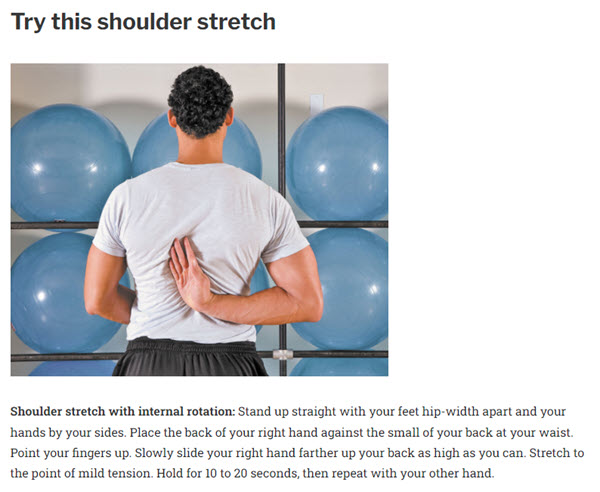
These strategies will help protect your shoulders, too.
Stretch right before activities.
Take a few minutes to stretch before activities requiring shoulder power, like lifting a heavy laundry basket or hanging curtains. “March in place for two minutes to get your blood pumping. Then put your left hand up high on the edge of a wall, and turn your body to the right, so you feel a stretch in your armpit. Then try it on the other side. Now put your left hand lower on the wall, about shoulder height. Turn your body to the right until you feel the stretch in the front of your shoulder, then repeat on the other side,” Dr. O’Donnell advises. (Also see “Try this shoulder stretch.”)
Do an easy shoulder strengthener.
“Place your right elbow at your waist, with your forearm in front of you, like you’re going to shake hands with someone. Now swing your hand in to your belly, then out as far as you can to your right, then back to your belly, then back to the right. Keep your elbow at your waist the whole time. Do this 10 times, then switch arms. Your shoulder will tire quickly, but you’ll be strengthening your rotator cuff muscles,” Dr. O’Donnell says.
Reduce fall hazards at home.
Eliminating hazards reduces your fall risk. Get rid of floor clutter and throw rugs, make sure hallways are well lit, add grab bars and floor treads to slippery bathrooms, fix broken steps and loose carpeting, and wear shoes with nonslip soles on hard floors.
Avoid lifting heavy objects overhead.
If possible, keep those objects at or below your waist. Hug them close (wrap your arms around them), use your legs for power, and stand up straight to reduce strain. Holding heavy objects away from your body and lifting them above your head can tear your rotator cuff.
(Tips from Harvard Health)





I have not got time to do the exercises at the moment. However, my plan is to do them another day. They look excellent, and thank you for forwarding them to me.
First time I’ve come across the Shoulder Stretch exercises – they will now become part of my daily routine and I hope will help loosen up an old rotator cuff injury which has dogged my free movements for several years.
I certainly hope they will. You will feel the benefit of the stretches, anyway.
Some you can do standing at the bench while you are waiting for something to come to the boil – especially the shoulder stretches. Good on you for planning to do them soon.
I’ve never heard of these shoulder strengtheners, but I like the easy shoulder strengthener, as well as the exercise illustrated, i.e. shoulder stretch with internal rotation.
Thank you very much for posting this information!